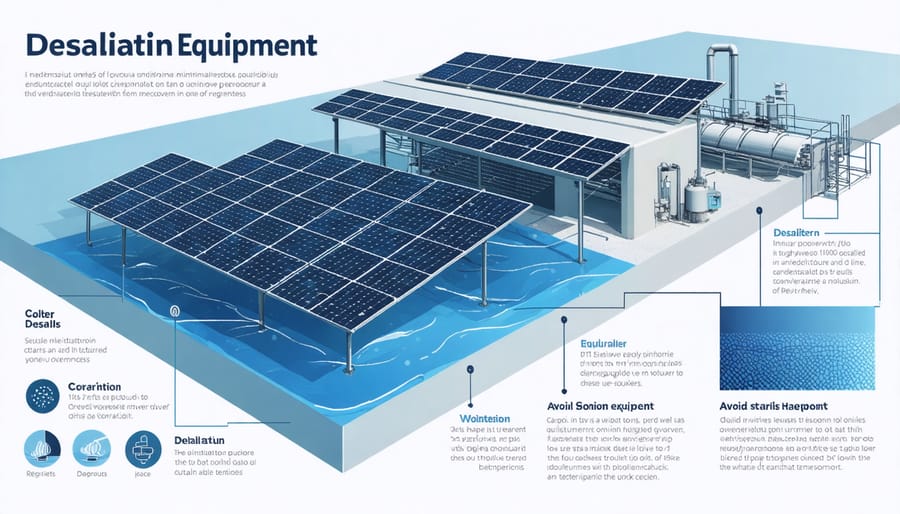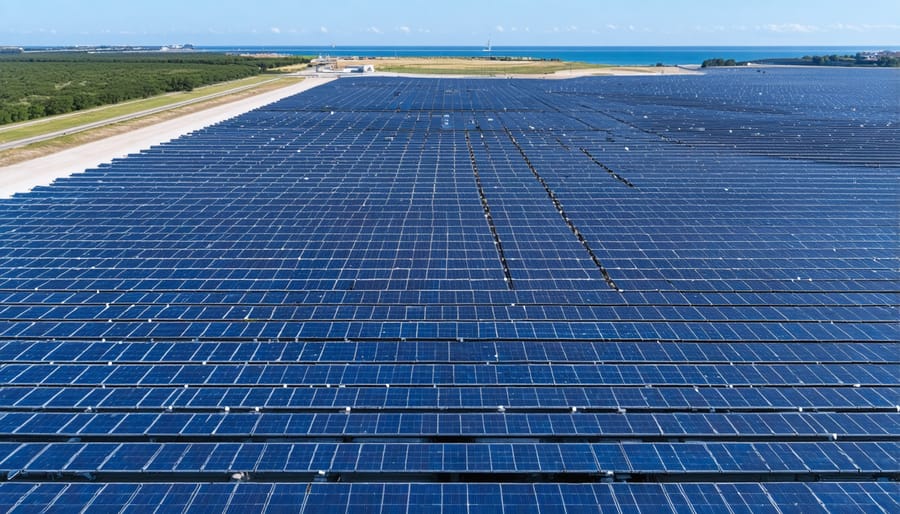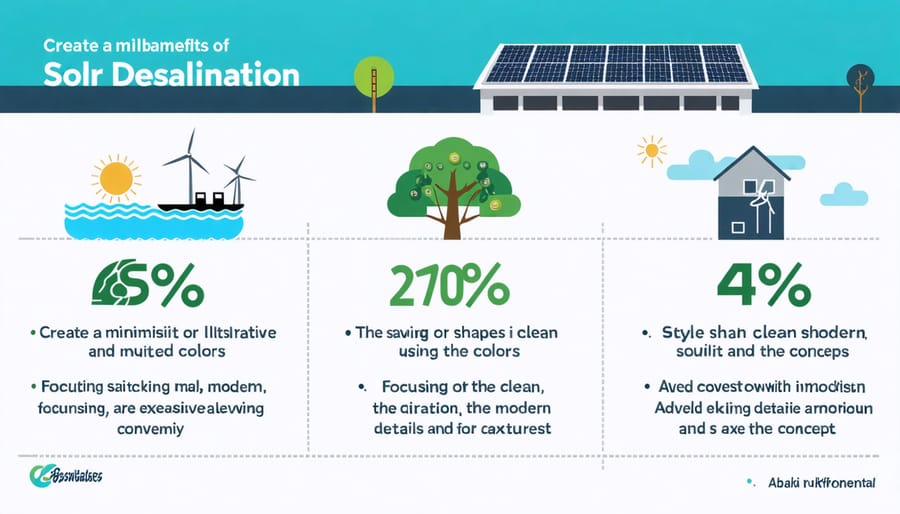Solar-Powered Water Desalination: The European Solution to Water Scarcity

As global freshwater scarcity intensifies, solar-powered desalination emerges as a groundbreaking solution that harnesses abundant sunlight to transform seawater into clean, drinkable water. This innovative technology combines advanced membrane systems with renewable solar energy, offering a sustainable answer to water security challenges across Europe and beyond. Recent technological breakthroughs have reduced operational costs by 60% while increasing efficiency to unprecedented levels, making solar desalination increasingly viable for coastal communities and industries.
The marriage of solar power and water desalination represents a crucial advancement in sustainable water management, particularly in water-stressed Mediterranean regions. Modern systems can produce up to 5,000 liters of fresh water daily using only solar energy, eliminating the carbon footprint traditionally associated with conventional desalination processes. This development arrives at a critical moment, as projections indicate that 60% of European coastal regions will face severe water stress by 2040.
This technology stands at the forefront of the European Union’s commitment to sustainable development, offering a compelling demonstration of how renewable energy can address fundamental human needs while supporting environmental conservation goals.
The Integration of Solar Power and Desalination Technology
Solar Energy Collection Methods
Solar-powered desalination relies on two primary energy collection methods: photovoltaic and thermal solar systems. Photovoltaic (PV) panels convert sunlight directly into electricity, powering the pumps and control systems essential for the desalination process. These systems offer reliable performance and are particularly effective in regions with high solar irradiance across Europe.
Thermal solar collectors, alternatively, harness the sun’s heat energy to drive the desalination process directly. These systems use specially designed collectors that concentrate solar radiation to heat the feedwater, facilitating efficient evaporation. The most common configurations include parabolic troughs and evacuated tube collectors, which can achieve temperatures suitable for various desalination techniques.
Many modern installations combine both collection methods to maximize efficiency and ensure consistent operation. This hybrid approach allows facilities to leverage the advantages of both technologies: PV panels provide stable electrical power for core operations, while thermal collectors reduce the overall energy demand by pre-heating the water. This integration results in more sustainable and cost-effective desalination solutions for European communities and industries.
Desalination Process Integration
The integration of solar power with desalination systems creates a sustainable and efficient water purification solution. Solar panels connect to the desalination equipment through sophisticated power management systems that ensure consistent energy supply. These systems typically incorporate energy storage solutions, such as batteries, to maintain operation during periods of low sunlight.
Two primary integration approaches exist: direct and indirect coupling. Direct coupling uses solar photovoltaic (PV) panels to power reverse osmosis or thermal desalination units immediately. Indirect coupling incorporates an intermediate power conversion system, offering greater flexibility but slightly reduced efficiency.
Modern integration designs feature smart controllers that optimize energy distribution based on water demand and available sunlight. These controllers can adjust operational parameters in real-time, ensuring maximum efficiency while protecting system components from power fluctuations.
For European installations, grid connection often serves as a backup power source, creating a hybrid system that guarantees uninterrupted operation. This integration approach has proven particularly successful in Mediterranean regions, where abundant sunlight and water scarcity create ideal conditions for solar-powered desalination.


Hybrid System Components and Configuration
Solar Panel Arrays
Solar panel arrays for desalination systems require careful configuration to ensure optimal performance and energy efficiency. A typical installation needs 2-4 kWh of energy to produce one cubic meter of fresh water, demanding robust solar infrastructure. Modern arrays utilize high-efficiency photovoltaic panels, usually monocrystalline or polycrystalline, with conversion rates exceeding 20%.
For reliable operation, systems typically incorporate redundancy through multiple panel strings, ensuring consistent power supply even during partial shading or maintenance. The arrays must be sized according to the desired daily water output, local solar irradiance levels, and seasonal variations in sunlight availability.
European installations generally require 20-25% more panel capacity compared to equatorial regions to compensate for lower solar intensity and shorter winter days. Smart tracking systems can enhance energy capture by up to 30%, though they increase initial investment costs. Integration with energy storage solutions, such as batteries or thermal storage, ensures continuous operation during non-peak solar hours.
Panel placement must consider factors like wind loads, salt spray exposure, and ease of maintenance, with elevated mounting systems being preferred in coastal installations.
Energy Storage Solutions
Reliable energy storage solutions are crucial for maintaining continuous operation in solar-powered desalination systems. Advanced lithium-ion battery systems, coupled with smart energy management controllers, ensure consistent power supply even during cloudy periods or nighttime operations. These systems typically incorporate multi-day storage capacity, allowing facilities to operate at optimal efficiency regardless of weather conditions.
Modern storage configurations feature modular designs that can be scaled according to specific project requirements. Integrated monitoring systems provide real-time data on energy consumption, storage levels, and system performance, enabling precise control over the desalination process. This intelligent energy management helps maintain stable operation while maximizing cost efficiency.
For enhanced reliability, many European installations now implement hybrid storage solutions, combining batteries with other storage technologies such as thermal energy storage. This approach provides redundancy and extends system longevity, ensuring sustainable operation throughout the year.
Desalination Units
Modern solar-powered desalination systems come in several configurations, each optimized for specific applications and environments. Reverse osmosis (RO) units are the most common, offering high efficiency and reliability for both small-scale and industrial installations. These systems use semi-permeable membranes and pressure to separate salt from water, requiring minimal maintenance while delivering consistent performance.
Multi-effect distillation (MED) units excel in larger installations, particularly in regions with abundant solar resources. They operate by creating multiple stages of evaporation and condensation, maximizing energy efficiency through heat recovery. For smaller applications, solar still systems provide a straightforward solution, though with lower output capacity.
Membrane distillation units represent an emerging technology, combining thermal and membrane processes. These systems are particularly suitable for remote locations and can operate effectively with variable solar input. Innovation in materials and design continues to improve unit efficiency, making solar-powered desalination increasingly viable for European markets seeking sustainable water solutions.
Implementation and Benefits
Installation Requirements
A solar-powered water desalination system requires careful consideration of several key installation elements. The primary space requirement includes a dedicated area for solar panels, typically needing 10-15 square meters per kilowatt of capacity, positioned for optimal sun exposure. The desalination unit itself requires a compact footprint of approximately 5-8 square meters, depending on the system’s capacity.
Essential infrastructure requirements include a stable foundation for equipment mounting, proper drainage systems, and secure storage areas for treated water. The installation site must have adequate access to seawater or brackish water sources, with appropriate piping infrastructure for both intake and discharge.
Technical prerequisites encompass reliable electrical connections, monitoring systems, and safety equipment. A professional assessment of your site’s solar potential is crucial, considering factors such as annual solar radiation levels and seasonal variations. The system also requires integration with existing water distribution networks and compliance with local building codes and environmental regulations.
For optimal performance, the installation area should be well-ventilated and protected from extreme weather conditions. Regular maintenance access points must be incorporated into the layout design, ensuring easy system servicing and component replacement when needed.
Environmental Impact
Solar-powered desalination represents a significant leap forward in sustainable water treatment technology, offering substantial environmental benefits compared to conventional desalination methods. By harnessing solar energy, these systems dramatically reduce the carbon footprint associated with water purification, as they eliminate or minimize the need for grid electricity or fossil fuels.
The environmental impact is particularly noteworthy in terms of emissions reduction. A typical solar-powered desalination plant can prevent the release of approximately 1,000 tonnes of CO2 per year for every million litres of water processed, compared to traditional grid-powered systems. This reduction in greenhouse gas emissions contributes significantly to climate change mitigation efforts.
Moreover, modern solar desalination systems are designed with minimal environmental disruption in mind. The brine discharge, a common concern in desalination processes, can be managed more effectively through advanced dilution techniques and careful site selection. Many installations now incorporate brine management systems that help protect marine ecosystems.
The technology also promotes circular economy principles by potentially integrating waste heat recovery and mineral extraction from brine. This approach not only maximises resource efficiency but also creates additional value streams while minimising environmental impact, making it a truly sustainable solution for water security challenges.

Economic Advantages
Solar-powered desalination systems offer compelling economic advantages that extend far beyond initial sustainability benefits. The integration of solar energy significantly reduces operational costs by minimising reliance on conventional power sources, with many facilities reporting energy cost reductions of 40-60% compared to traditional grid-powered systems.
For coastal communities and businesses, the return on investment (ROI) typically materialises within 5-7 years, depending on local solar conditions and water demand. The economic equation becomes particularly attractive when considering that maintenance costs are generally 30% lower than traditional desalination plants, primarily due to fewer moving parts and simplified operational requirements.
European businesses implementing these systems benefit from various regional incentives and green energy subsidies, further enhancing the financial proposition. A medium-sized installation serving 1,000 households can achieve operational cost savings of €15,000-25,000 annually, while larger industrial applications demonstrate even more substantial returns.
The scalability of solar-powered desalination systems allows for modular expansion, enabling businesses to manage capital expenditure effectively while matching growing water demands. This flexibility, combined with decreasing solar technology costs and increasing water prices, creates a compelling economic case for long-term investment in sustainable water solutions.
Future Developments and Support
Technological Advancements
Recent breakthroughs in emerging solar technologies are revolutionising water desalination processes across Europe. Advanced membrane materials, combined with high-efficiency photovoltaic systems, have significantly improved energy conversion rates and water purification capabilities.
Innovative nanomaterial technologies are enhancing membrane performance, reducing fouling issues while increasing water throughput. These improvements have led to more compact and efficient desalination units that require less maintenance and deliver higher quality freshwater output.
Smart monitoring systems, powered by artificial intelligence, now enable real-time optimization of the desalination process. These systems automatically adjust operating parameters based on solar intensity, water quality, and demand patterns, maximizing system efficiency throughout the day.
Concentrated solar power (CSP) integration is showing promising results in pilot projects across Mediterranean regions. By combining thermal and electrical solar energy, these hybrid systems achieve higher overall efficiency rates while maintaining consistent operation even during periods of reduced sunlight.
Moreover, modular design approaches are making solar-powered desalination more accessible to various scales of implementation. From household units to industrial-scale installations, these systems can be easily scaled and adapted to meet specific needs while maintaining optimal performance levels.
Project Support Services
Our dedicated team of European consultants provides comprehensive support throughout your solar-powered desalination project journey. From initial feasibility studies to system implementation and maintenance, we ensure your investment delivers optimal results for your specific needs.
We begin with a detailed site assessment, analyzing your water requirements, solar resource availability, and spatial constraints. Our experts then develop customised system designs that maximise efficiency while meeting local regulations and environmental standards. During the planning phase, we assist with permitting processes and coordinate with local authorities to ensure compliance with EU water quality directives.
Implementation support includes vendor selection, quality control, and project management services. We work with certified European manufacturers and installers to maintain high standards and ensure system reliability. Our team provides thorough documentation and training for your operational staff, enabling smooth system handover and continued efficient operation.
Post-installation, we offer ongoing technical support and maintenance services. Regular system monitoring, performance optimization, and preventive maintenance help maintain peak efficiency. We also provide guidance on potential system upgrades and expansions as your needs evolve.
For municipalities and industries, we facilitate access to EU sustainability grants and funding programmes, helping make solar desalination projects more financially viable. Our experience with European regulations and standards ensures your project meets all necessary requirements while maximizing environmental benefits.
Solar-powered desalination represents a transformative solution for Europe’s water security challenges, offering a sustainable path forward in an era of increasing water scarcity. As demonstrated throughout this analysis, the integration of solar energy with desalination technologies presents compelling advantages for European regions, particularly in Mediterranean countries where water stress coincides with abundant solar resources.
The technology’s rapid advancement has made it increasingly viable for various scales of implementation, from small community systems to large industrial installations. With improving efficiency rates and declining costs, solar-powered desalination is becoming more accessible to municipalities, businesses, and industries across Europe. The environmental benefits are particularly noteworthy, as these systems significantly reduce carbon emissions compared to conventional desalination methods while providing a reliable water supply.
Looking ahead, the European Union’s commitment to renewable energy and water sustainability creates a favorable environment for the expansion of solar-powered desalination. Investment in research and development continues to drive innovation, promising even more efficient and cost-effective solutions in the coming years. For European stakeholders, the technology offers a practical approach to water security that aligns with climate goals and sustainable development objectives.
As water stress intensifies due to climate change, solar-powered desalination stands ready to play a crucial role in Europe’s water management strategy, providing a sustainable solution that harnesses abundant solar resources while ensuring water security for future generations.
Leave a Reply